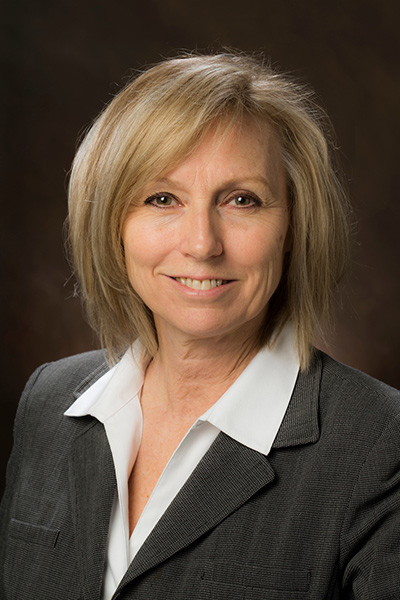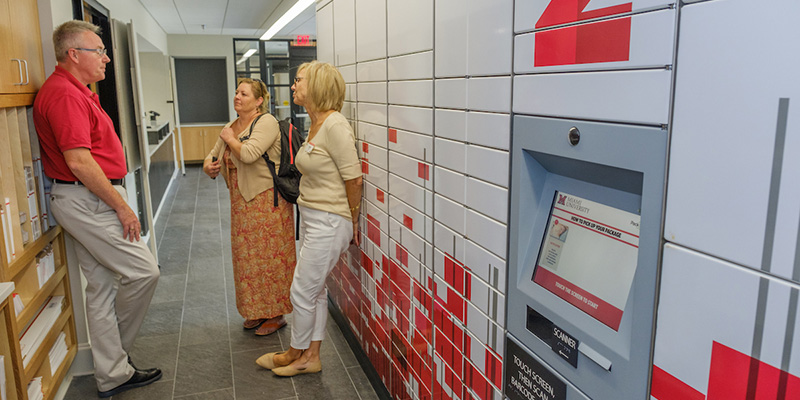

Miami's Mail and Package Center moved to its new location this summer.
Photo: Scott Kissell
Aug 24, 2017
Anita Byrd has used her creative side to improve Miami's mail service

Anita Byrd
By Kristal Humphrey, university news and communicationsDuring her 38 years at Miami, Anita Byrd has worked in student financial aid, conferences and continuing education, and personnel but has spent most of her time working in Miami’s mail center. After more than 20 years, Byrd, manager of the Miami Mail & Package Center, will retire this month. Her last day on campus is Friday, Aug. 25.
She has been at the university under seven presidents, helped the mail center move twice, and seen how technology has affected mail services.
Q: What do you do as manager of the Mail & Package Center?
A: I manage the daily activities of the office and postal operations, which includes overseeing the postal accounts and the university’s permits for bulk mailings. There are postal service regulations we have to follow to use the nonprofit permits.
As the contact person for the postal service, I take care of any problems with the mailings. I also manage the contracts with our other mail carriers and equipment vendors.
I handle scheduling and hiring, as well as financial things like the budget, daily financial reporting required by the post office, deposits, and postal audits of our contract station, which is where we sell stamps and packages. We are a branch of the U.S. post office.
Q: What were things like when you first started?
A: I started in the mailroom when it was in Robertson Hall. At that time, it was a single room office with only two staff and 10-15 student employees. The other full-time person was out on delivery routes all day. Campus mail was delivered twice a day with two campus mail driving routes — one each morning and afternoon — and eight walking routes done by students.
There were no computers and just one scale and one postage meter. Back then offices didn’t have desktop computing, so there was a route that went to the computing center to pick up outputs and deliver them to departments. For example, when admission ran acceptance letters. Also, when departments wanted backup tapes to go to the computing center, we would pick them up and deliver them.
Our outbound volume of mail, including bulk mailings, was as large as the incoming volume of letters. We had to manually presort the bulk mailings for the post office, and it took awhile to do. For example, student’s grades were mailed to their homes at that time, and we had to sort them by zip code, putting rubber bands and stickers on each sorted bundle. Starting in early afternoon, it took two people about 4-5 hours to do.
Mail was about 75 percent of our workload and packages amounted to only 25 percent, with first-class, letter-size mail being the largest amount. Most of the mail we handled and services we provided were administrative, about 90 percent.
The amount of student mail was low because student packages and mail were delivered directly to residence halls from UPS, FedEx, etc. The resident assistants passed out packages and put mail in students’ mailboxes. We delivered campus mail to residence halls.
Q: How did things change when you moved to Wells Hall?
A: The supply room and the post office from Shriver moved with us, becoming part of the mail center, and we started using a new tracking software system. We also created the student package center, which meant students no longer received packages at their hall. When the package center first opened, students handed their IDs to two or three staff members to get their packages. Eventually it changed to using a kiosk.
Later in our time at Wells, the automation service, postage meter service and supplies were outsourced. United Mail now handles our automation and postage meter service, and there’s a website with instructions and the bulk automation request form.
Also, the campus mail volume decreased significantly as departments started sending scans and using email more. With that decrease, we switched from two delivery routes a day to one a day.
Q: What are things like now and how are things different in the Shriver location?
A: Now incoming and outbound letter-size mail is minimal and the number of packages — coming in and going out — is large. Now that we have moved to Shriver, students are using smart lockers to pick up their packages. Students living on campus receive an email message telling them they have a package available for pickup. They are able to pick up their package at their convenience, as the lockers are available 24/7.
We also have package delivery service and a new service called Pack & Ship, where our staff will professionally pack and ship items for faculty, staff, students and the Oxford community.
Starting this fall, we will deliver student letter mail to residence life, and the resident directors will pick it up and take it back to the halls. The resident directors have to go there anyway to get their own mail, so it makes sense for them to pick up their residents’ mail.
Q: What was your biggest challenge?
A: When we moved to Wells and all the changes and new things that came with that move.
With the current project — the smart lockers — we were able to project volumes from the previous years, and along with the experience of package handling, I feel we are more prepared. With the move to Wells Hall, everything was new to all of us, and we had no previous information available to plan with. New software, lack of information regarding the number of incoming packages and combining several offices into one created a challenge. When we opened the package center, students were lined up out the door to Spring Street.
Q: What have you enjoyed the most?
A: The challenges and projects through the years: the constant evaluation of services and working on projects such as the automation service, Wells mail center and smart locker project. I like analyzing what we do and finding better ways to do it. I’ve been encouraged and empowered to use my creative side.
I also have enjoyed the people I have worked with at the university, as well as the students. They keep us young.
Q: What are your plans when you retire?
A: Spending time with my first grandchild who was born July 1. I’ll also enjoy going to our lake home and visiting my kids, who live out of town. I love to read and may take a class.
